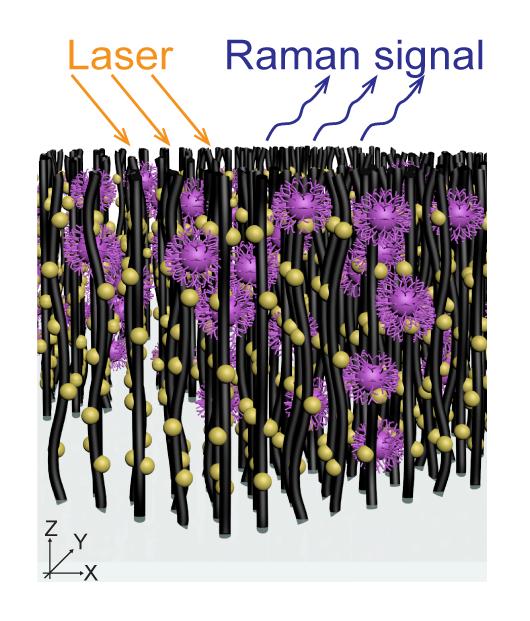
Credit: Terrones Lab/Penn State
A device to quickly capture and identify various strains of virus has been developed, according to researchers at Penn State and New York University.
Currently, virologists estimate that 1.67 million unknown viruses are in animals, a number of which can be transmitted to humans. Known viruses, such as H5N1, Zika and Ebola have caused widespread illness and death. The World Health Organization states that early detection can halt virus spread by enabling rapid deployment of countermeasures.
“We have developed a fast and inexpensive handheld device that can capture viruses based on size,” said Mauricio Terrones, distinguished professor of physics, chemistry, and materials science and engineering at Penn State. “Our device uses arrays of nanotubes engineered to be comparable in size to a wide range of viruses. We then use Raman spectroscopy to identify the viruses based on their individual vibration.”
This device, called a VIRRION, has a wide range of possible uses. For farmers, for example, early detection of a virus in the field can save an entire crop. Early detection of a virus in livestock can save a herd from illness. Humans also will benefit by the detection of viruses in minutes rather than in days with current methods. Because of its size and low cost, such a device would be useful in every doctor’s office as well as in remote locations when disease outbreaks occur.
“Most current techniques require large and expensive pieces of equipment,” Terrones said. “The VIRRION is a few centimeters across. We add gold nanoparticles to enhance the Raman signal so that we are able to detect the virus molecule in very low concentrations. We then use machine learning techniques to create a library of virus types.”
According to Professor Elodie Ghedin, a virologist at NYU, “The VIRRION enables the rapid enrichment of virus particles from any type of sample — environmental or clinical — which jump-starts viral characterization. This has applications in virus emergence, virus discovery and in diagnosis. Eventually, we hope to use this device for the capture and sequencing of single virions, giving us a much better handle on the evolution of the virus in real time.”
Added lead author Ying-Ting Yeh, an assistant research professor in the Terrones group, “We synthesized a gradient of aligned carbon nanotube forest arrays to capture different viruses according to their size and detect them in-situ using Raman spectroscopy. We designed and assembled a portable platform that enriches virus particles from several milliliters of clinical samples in a couple of minutes.”
###
The work is published today (Dec. 23) in Proceedings of the National Academy of Sciences. Titled “A rapid and label-free platform for virus capture and identification from clinical samples,” the paper’s co-authors are Ying-Ting Yeh, an assistant research professor in Terrones’ group; Kristen Gulino, Tsui-Wen Chou and Bin Zhou, all of NYU; and YuHe Zhang, Aswathy Sabestien, Zhong Lin, Istvan Albert, Huaguang Lu and Venkataranman Swaminathan, all of Penn State.
The National Science Foundation Growing Convergence Research Big Idea, the Thrasher Research Fund, an Infectious Disease Research Exchanges Grant from Princeton University and the startup fund from Penn State supported this work.
Media Contact
A’ndrea Elyse Messer
[email protected]
814-865-5689




